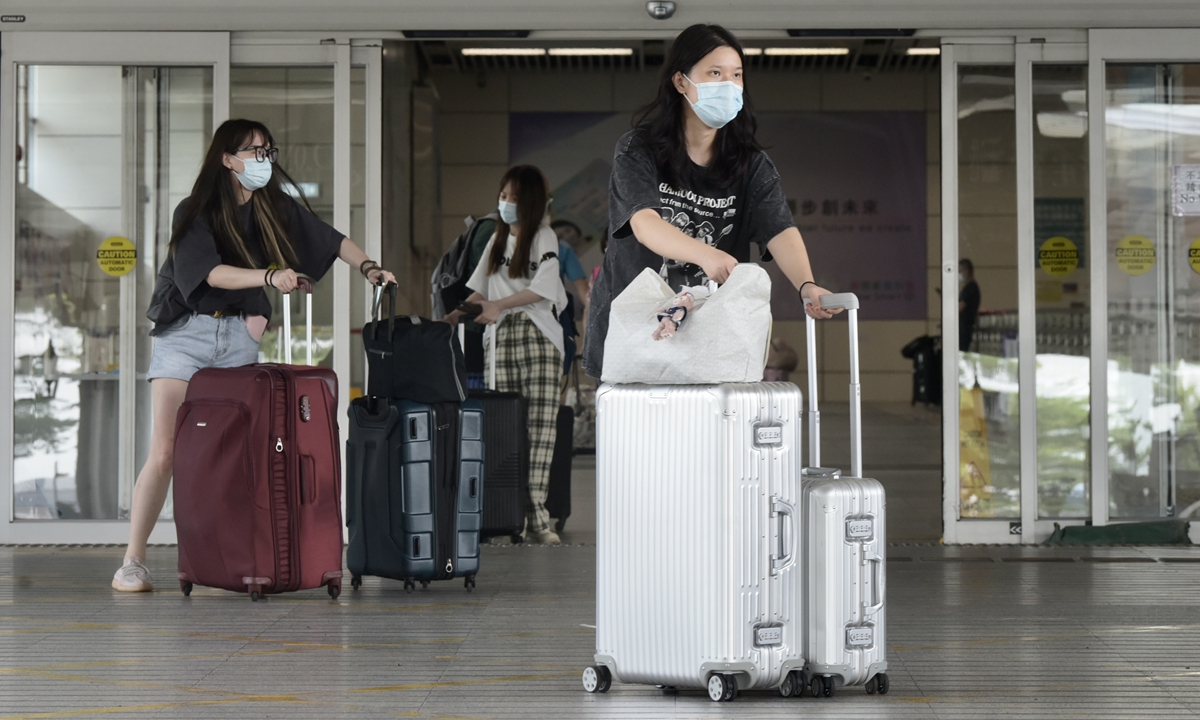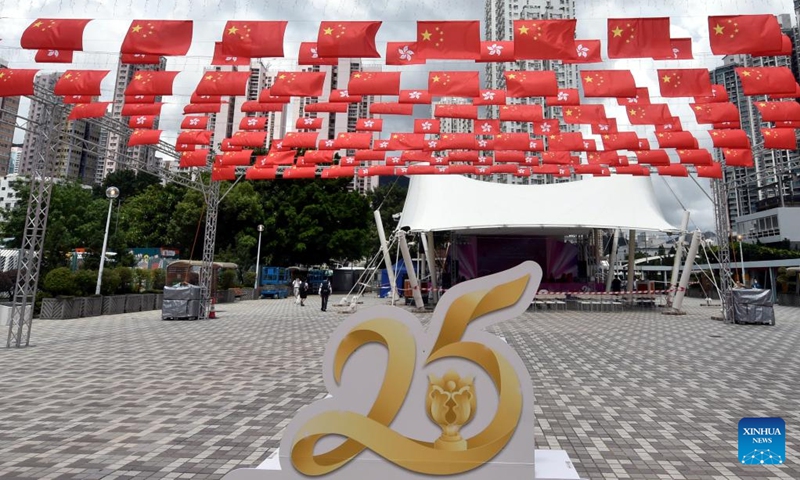
Passengers enter Hong Kong at the Shenzhen Bay Port in September, 2021. Photo: IC
Yu Fan, who works in Shenzhen, South China's Guangdong Province, has never felt that he and his wife were in a "long-distance relationship," even though his wife, a resident of the Hong Kong Special Administrative Region (HKSAR), worked across the border in the HKSAR.
"Thanks to the opening of the Guangzhou-Shenzhen-Hong Kong Express Rail Link, it takes only about 20 minutes to travel from Shenzhen to downtown Hong Kong, and my wife and I can easily see each other on weekdays. My friend joked that it takes longer to meet up across different districts in Beijing than our 'long-distance relationship'," Yu told the Global Times.
Yu's wife also has never felt seriously separated from her husband due to distance over the past years. "We seemingly live in the same social circle thanks to increasingly convenient transport facilities in the Greater Bay Area," Yu's wife, surnamed Ting, told the Global Times.
The story of Yu and Ting is also the tale of Shenzhen and Hong Kong over the past 25 years since Hong Kong's return to the motherland in 1997. Over the past quarter-century, as the HKSAR increasingly integrated with the mainland, Shenzhen and Hong Kong - two cities separated by a thin stretch of water - have worked closely to create their own "tale of two cities."
Thanks to the ever closer links between Shenzhen and the HKSAR in terms of economic development and infrastructure, many like Yu and Ting can fully take advantage of what the two cities have to offer on daily basis.
"In the past 25 years since Hong Kong's return to China, the practice of 'one country, two systems' has also yielded notable results. The cooperation between Shenzhen and Hong Kong is a hand in glove partnership, to be interdependent and mutually accomplished." Li Xiaobing, an expert on Hong Kong affairs from Nankai University, told the Global Times. "In the future, more positive and vivid stories of the twin cities will be played out here."
According to a KPMG employment trends research report released in April, the proportion of Hong Kong respondents willing to move to cities in the Greater Bay Area has increased from 52 percent in 2019 to 72 percent in 2022. Among the respondents, 63 percent and 62 percent cited career and industry development prospects, respectively, in addition to transportation convenience as the main reasons for the move.
The Hong Kong-Zhuhai-Macao Bridge, the world's longest cross-sea bridge, as well as the high-speed railway, have helped Yu's two-city life become reality. Thanks to the bridge, drivers traveling between the three localities no longer need to take lengthy detours. The trip from Hong Kong to the two other cities was cut from 200 km to 65km, equal to shortening from three and a half hours to merely 45 minutes.
"Sometimes I bring his favorite Hong Kong snacks to visit him in Shenzhen, and they are still hot and crisp after arriving. In recent years, the customs clearance goes faster and more efficient among the Greater Bay Area," Ting said. "We still remember the excitement of seeing each other after work, and the wait gradually turned from hours to as little as 30 minutes."
Yu noted that mobile payments in Hong Kong are increasingly popular, which also reflects the integration process of the Greater Bay Area. "'Scan the code for payment' gradually become a new way of commerce throughout Hong Kong streets, and some of our payment habits are gradually converging to the mainland," he suggested.
Despite the impact of the epidemic, like many Hong Kong residents, Yu still enjoys the convenience of inter-city shopping in Greater Bay Area through digital channels.
To support Hong Kong's fight against the epidemic, Shenzhen has timely opened up waterways, railways and other transport channels to ensure Hong Kong's supplies remain undisrupte. "As long as there is a warehouse in Shenzhen, even during the epidemic, it only takes two days from placing an order to receiving the goods," Yu noted.

China's national flags and the Hong Kong Special Administrative Region (HKSAR) flags fly along a street in Hong Kong, south China, June 29, 2022. July 1 this year marks the 25th anniversary of Hong Kong's return to the motherland.(Photo: Xinhua)
Deeper bondDuring the HKSAR's fight COVID-19, what Shenzhen offered was more than just keeping transport channels open.
Lu Hao, a legal executive at China State Construction International Ltd, a State-owned enterprise based in Hong Kong and Shenzhen, will never forget the scenes in December 2020 when he went to Hong Kong from Shenzhen Bay Port for the first time after taking a new job.
At that time, the COVID-19 epidemic was raging in the HKSAR, many people there regarded Shenzhen as a safe harbor, Lu noted. "At the port, we were among the few travelers heading to Hong Kong, but when I heard the border staff talk to me that 'I know you are here to help us,' I felt that my decision was not wrong," Lu told the Global Times.
The efficient collaboration between the mainland and HKSAR governments and enterprises resulted in a construction miracle: a hospital that would have taken four years to build was erected in four months.
As the outbreak is gradually brought under control in Hong Kong, Lu's work has returned to his area of expertise. Through his company's projects and research programs in the Lok Ma Chau Loop, the Qianhai Shenzhen-Hong Kong Modern Service Industry Cooperation Zone, Lu has gained a deeper understand of the integration of the HKSAR and the mainland.
The Hong Kong-Shenzhen Innovation and Technology Park in the Lok Ma Chau Loop is operating at full capacity, in total over ten professional affiliated parks have been put into use. In the west part of Shenzhen, after more than ten years of development, in 2021, the Qianhai Shenzhen-Hong Kong Modern Service Industry Cooperation Zone has attracted more than 2,400 Hong Kong-funded enterprises, each with registered capital of more than $10 million.
Over the past year and a half, shuttling between the two cities made Lu become familiar with Cantonese, and enjoys dealing with the people from both sides, forming relationships with many likeminded people.
Lu's colleague, Cheng Wunman, for example, a 27-year-old Hong Kong female who speaks fluent Putonghua, is also looking forward to future connectivity between Shenzhen and Hong Kong.
In 2012, when some mainland universities admitted Hong Kong students without extra examinations, Cheng was encouraged by her family to study in Beijing. Up to 2019 when she graduated with a master's degree, coinciding with the introduction of the Outline Development Plan for the Guangdong-Hong Kong-Macao Greater Bay Area, Cheng was determined to stay and work in the Greater Bay Area.
Cheng is now in charge of marketing and planning for the development of the medical industry, she often travels to multiple cities spanning the Greater Bay Area in a single day for business meetings and work.
Cheng noted that when she was a child, Hong Kong and Shenzhen only engaged in a simple exchange of personnel, logistics and capital. Today, there is a growing demand for integration between the people of these two cities in a variety of industries, including retirement, healthcare, schooling, and home ownership.
"The huge market premium generated by an industrial cooperation and connectivity within these cooperation zones is forming a huge attraction for talent and growth industries," Cheng told the Global Times.
Data from the Human Resources and Social Security Bureau of Shenzhen Municipality shows that more than 37,000 Hong Kong residents are participating in the enterprise employee pension insurance program in Shenzhen as of the end of 2021, an increase of 204 percent compared to 2018 levels.





